英语笔译技巧--省略法
- 格式:docx
- 大小:13.31 KB
- 文档页数:3
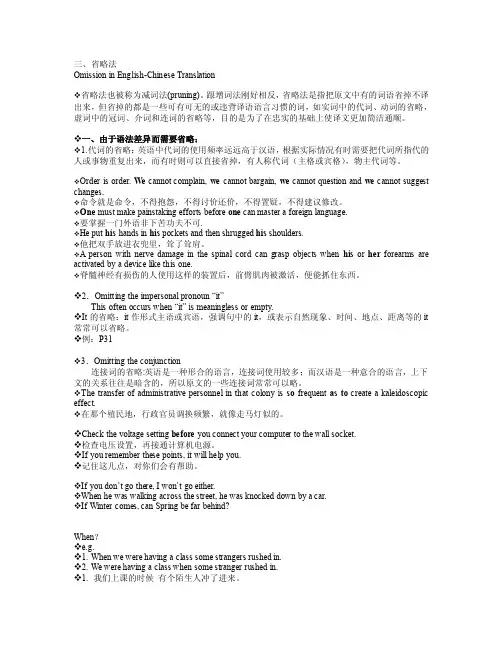
三、省略法Omission in English-Chinese Translation省略法也被称为减词法(pruning)。
跟增词法刚好相反,省略法是指把原文中有的词语省掉不译出来,但省掉的都是一些可有可无的或违背译语语言习惯的词,如实词中的代词、动词的省略,虚词中的冠词、介词和连词的省略等,目的是为了在忠实的基础上使译文更加简洁通顺。
一、由于语法差异而需要省略:1.代词的省略:英语中代词的使用频率远远高于汉语,根据实际情况有时需要把代词所指代的人或事物重复出来,而有时则可以直接省掉,有人称代词(主格或宾格),物主代词等。
Order is order. W e cannot complain, we cannot bargain, we cannot question and we cannot suggest changes.命令就是命令,不得抱怨,不得讨价还价,不得置疑,不得建议修改。
One must make painstaking efforts before one can master a foreign language.要掌握一门外语非下苦功夫不可.He put his hands in his pockets and then shrugged his shoulders.他把双手放进衣兜里,耸了耸肩。
A person with nerve damage in the spinal cord can grasp objects when his or her forearms are activated by a device like this one.脊髓神经有损伤的人使用这样的装置后,前臂肌肉被激活,便能抓住东西。
2.Omitting the imp ersonal pronoun “it”This often occurs when “it” is meaningless or empty.It的省略:it作形式主语或宾语,强调句中的it,或表示自然现象、时间、地点、距离等的it 常常可以省略。
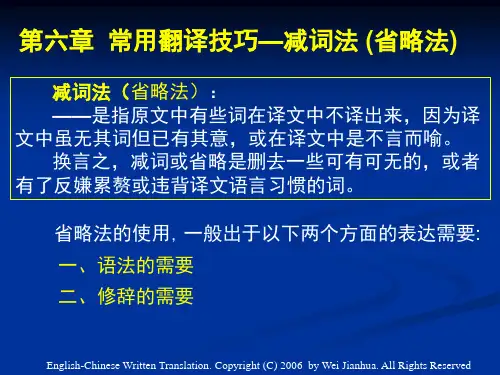
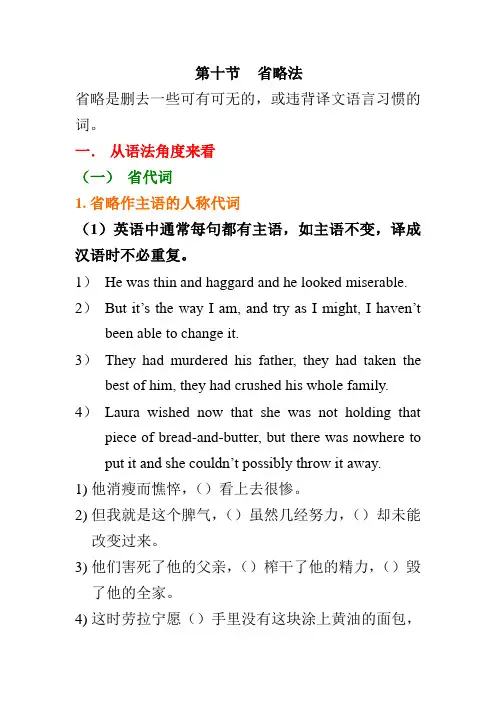
第十节省略法省略是删去一些可有可无的,或违背译文语言习惯的词。
一.从语法角度来看(一)省代词1.省略作主语的人称代词(1)英语中通常每句都有主语,如主语不变,译成汉语时不必重复。
1)He was thin and haggard and he looked miserable. 2)But it’s the way I am, and try as I might, I haven’t been able to change it.3)They had murdered his father, they had taken the best of him, they had crushed his whole family.4)Laura wished now that she was not holding that piece of bread-and-butter, but there was nowhere to put it and she couldn’t possibly throw it away.1)他消瘦而憔悴,()看上去很惨。
2)但我就是这个脾气,()虽然几经努力,()却未能改变过来。
3)他们害死了他的父亲,()榨干了他的精力,()毁了他的全家。
4)这时劳拉宁愿()手里没有这块涂上黄油的面包,拿着又没有地方放,()又不可能扔掉。
作业:1.I am 78 years old; I have been confined to my room with a paralytic stroke for the past 14 months.2. Like his friend he had many wonderful ideas, but he only put a few into practice.3. We can measure the amount of water in a pot, but we can’t measure its heat. We haven’t an instrument for that.4. The Grand Dukes always liked new ideas, and later they were good friends of Galileo.(2)泛指的英语人称代词作主语时,即使是第一个主语,汉译时也可省略。
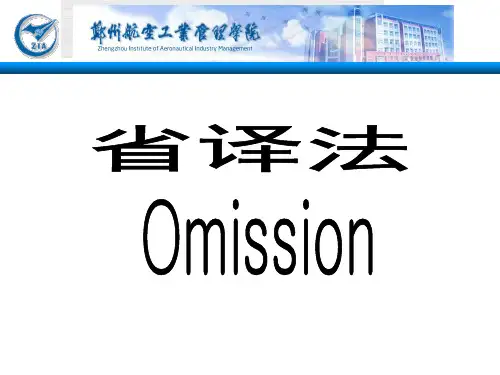
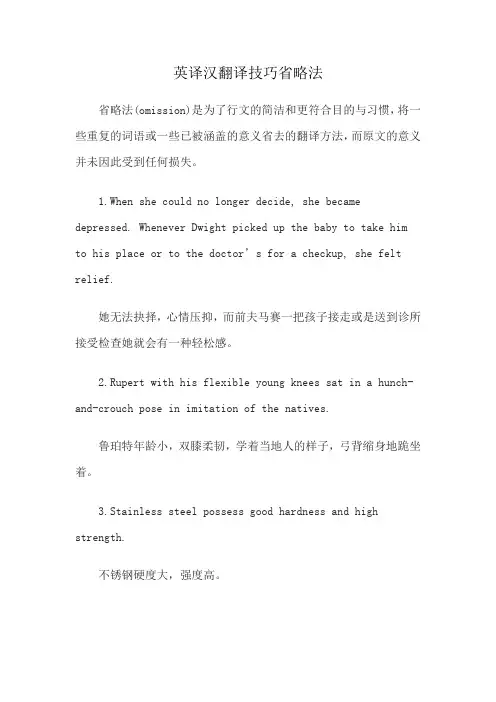
英译汉翻译技巧省略法省略法(omission)是为了行文的简洁和更符合目的与习惯,将一些重复的词语或一些已被涵盖的意义省去的翻译方法,而原文的意义并未因此受到任何损失。
1.When she could no longer decide, she became depressed. Whenever Dwight picked up the baby to take him to his place or to the doctor’s for a checkup, she felt relief.她无法抉择,心情压抑,而前夫马赛一把孩子接走或是送到诊所接受检查她就会有一种轻松感。
2.Rupert with his flexible young knees sat in a hunch-and-crouch pose in imitation of the natives.鲁珀特年龄小,双膝柔韧,学着当地人的样子,弓背缩身地跪坐着。
3.Stainless steel possess good hardness and high strength.不锈钢硬度大,强度高。
4.Penicillin works by not allowing a bacterium to build its cell wall.青霉素的作用是不让细菌制造细胞壁。
5. This is the solid rocky bottom under the ooze and mud of the ocean floor.海底软泥和泥层下面是坚硬的岩石层。
6. There is a 30% increase of our installed capacity with this year.今年,我们的装机容量增加了 30%。
7.在工作中,我们必须避免犯不必要的的错误。
We must avoid making mistakes in our work.8.质子带阳电,电子带阴电,而中子既不带阳电也不带阴电。
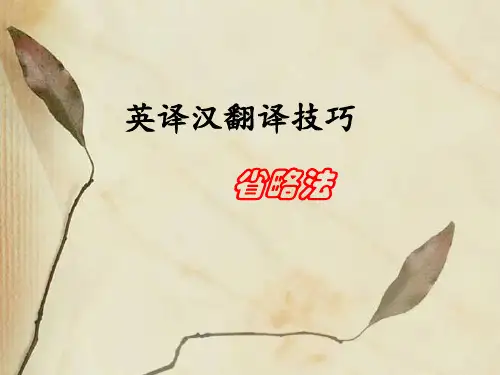
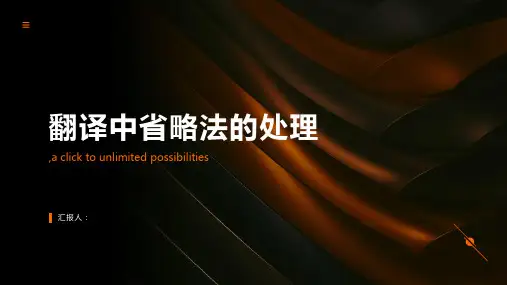
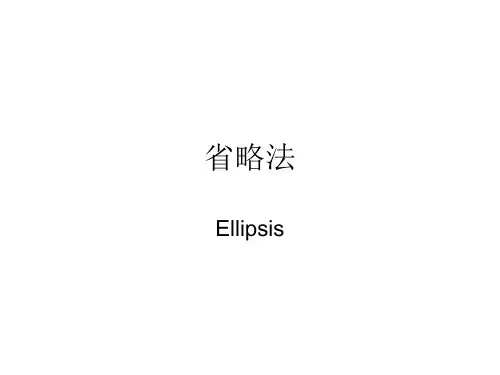
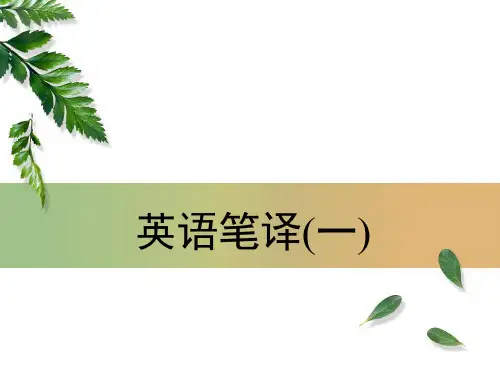
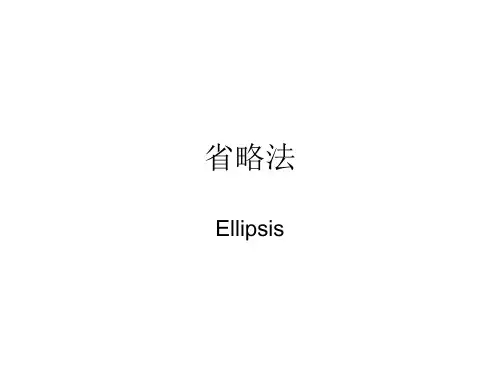
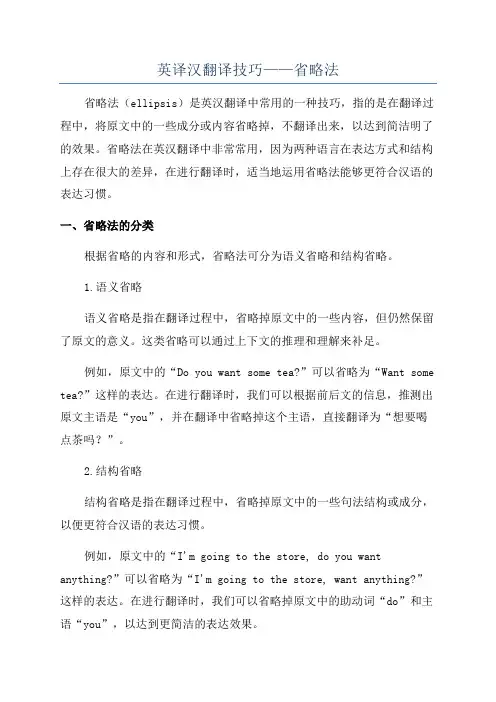
英译汉翻译技巧——省略法省略法(ellipsis)是英汉翻译中常用的一种技巧,指的是在翻译过程中,将原文中的一些成分或内容省略掉,不翻译出来,以达到简洁明了的效果。
省略法在英汉翻译中非常常用,因为两种语言在表达方式和结构上存在很大的差异,在进行翻译时,适当地运用省略法能够更符合汉语的表达习惯。
一、省略法的分类根据省略的内容和形式,省略法可分为语义省略和结构省略。
1.语义省略语义省略是指在翻译过程中,省略掉原文中的一些内容,但仍然保留了原文的意义。
这类省略可以通过上下文的推理和理解来补足。
例如,原文中的“Do you want some tea?”可以省略为“Want some tea?”这样的表达。
在进行翻译时,我们可以根据前后文的信息,推测出原文主语是“you”,并在翻译中省略掉这个主语,直接翻译为“想要喝点茶吗?”。
2.结构省略结构省略是指在翻译过程中,省略掉原文中的一些句法结构或成分,以便更符合汉语的表达习惯。
例如,原文中的“I'm going to the store, do you want anything?”可以省略为“I'm going to the store, want anything?”这样的表达。
在进行翻译时,我们可以省略掉原文中的助动词“do”和主语“you”,以达到更简洁的表达效果。
二、运用省略法的原则1.保持语意的完整性在运用省略法时,应尽量保持原文语意的完整性,避免省略导致语意不清或解释不明的情况发生。
例如,原文中的“I'm going shopping. See you later!”可以省略为“I'm going shopping. See you!”这样的表达。
虽然省略了“later”,但是通过上下文的推测,读者仍然能够理解原文的意思。
2.保持句子结构的完整性在运用省略法时,应尽量保持句子结构的完整性,避免省略导致句子结构混乱或文法错误的情况发生。
2.2.3 省略法省略法也被称为减词法(pruning)。
跟增词法刚好相反,省略法是指把原文中有的词语省掉不译出来,但省掉的都是一些可有可无的或违背译语语言习惯的词,如实词众的代词、动词的省略,虚词中的冠词、介词和连词的省略等,目的是为了在忠实的基础上使译文更加简洁通顺。
一、由于语法差异而需要省略:1.代词的省略:英语中代词的使用频率远远高于汉语,根据实际情况有时需要把代词所指代的人或事物重复出来,而有时则可以直接省掉,有人称代词(主格或宾格),物主代词等。
例1.Order is order. We cannot complain, we cannot bargain, we cannot question and we cannot suggest changes.命令就是命令,不得抱怨,不得讨价还价,不得置疑,不得建议修改。
例2.One must make painstaking efforts before one can master a foreign language.要掌握一门外语非下苦功夫不可.例3.He put his hands in his pockets and then shrugged his shoulders.他把双手放进衣兜里,耸了耸肩。
例4. A person with nerve damage in the spinal cord can grasp objects when his or her forearms are activated by a device like this one.脊髓神经有损伤的人使用这样的装置后,前臂肌肉被激活,便能抓住东西。
2.It的省略:it作形式主语或宾语,强调句中的it,或表示自然现象、时间、地点、距离等的it常常可以省略。
例:P313.连接词的省略:英语是一种形合的语言,连接词使用较多;而汉语是一种意合的语言,上下文的关系往往是暗含的,所以原文的一些连接词常常可以省略。
第十节省略法省略是删去一些可有可无的,或违背译文语言习惯的词。
一.从语法角度来看(一)省代词1.省略作主语的人称代词(1)英语中通常每句都有主语,如主语不变,译成汉语时不必重复。
1)He was thin and haggard and he looked miserable. 2)But it’s the way I am, and try as I might, I haven’t been able to change it.3)They had murdered his father, they had taken the best of him, they had crushed his whole family.4)Laura wished now that she was not holding that piece of bread-and-butter, but there was nowhere to put it and she couldn’t possibly throw it away.1)他消瘦而憔悴,()看上去很惨。
2)但我就是这个脾气,()虽然几经努力,()却未能改变过来。
3)他们害死了他的父亲,()榨干了他的精力,()毁了他的全家。
4)这时劳拉宁愿()手里没有这块涂上黄油的面包,拿着又没有地方放,()又不可能扔掉。
作业:1.I am 78 years old; I have been confined to my room with a paralytic stroke for the past 14 months.2. Like his friend he had many wonderful ideas, but he only put a few into practice.3. We can measure the amount of water in a pot, but we can’t measure its heat. We haven’t an instrument for that.4. The Grand Dukes always liked new ideas, and later they were good friends of Galileo.(2)泛指的英语人称代词作主语时,即使是第一个主语,汉译时也可省略。
英语笔译技巧--省略法
2017年英语笔译技巧--省略法
省略的目的在于使译文更加通顺流畅,更符合译文习惯。
但需要注意的是,省略并不是把原文的某些思想内容删去,省略不能改变原文的意义。
现从语法角度和修辞角度分别举例探讨省略法:
省略法是指在翻译中,原文中有些词在译文中可以省略,不必翻译出来。
因为译文中虽然没有这个词,但是已经具有了原文这个词所表达的意思,或者这个词在译文中的意义是不言而喻的'。
(一)省代词
1.省略作主语的人称代词
(1)省略作主语的人称代词
根据汉语习惯,前句出现一个主语,后句如仍为同一主语,就不必重复出现。
英语中通常每句都有主语,因此人称代词作主语往往多次出现,这种人称代词汉译时常常可以省略。
Ihadmanywonderfulideas,butIonlyputafewintopractice.
我有很多美妙的想法,但是只把少数付诸实践了。
(2)英语中,泛指人称代词作主语时,即使是作第一个主语,在汉语译文中往往也可以省略。
Weliveandlearn.
活到老,学到老。
Whenwillhearrive?—Youcannevertell.
他什么时候到?——说不准。
2.省略作宾语的代词
英语中有些作宾语的代词,不管前面是否提到过,翻译时往往可以省略。
Pleasetakeofftheoldpictureandthrowitaway.
请把那张旧画取下来扔掉。
3.省略物主代词
英语句子中的物主代词出现的频率相当高。
一个句子往往会出现好几个物主代词,如果将每个物主代词都翻译出来,那么汉语译文就显得非常罗嗦。
所以在没有其他人称的物主代词出现的情况下,在翻译时物主代词大多被省略。
Iputmyhandintomypocket.
我把手放进口袋。
(二)代词it的省略
it起着代词的作用,在译文中,当它被用作非人称或没有意义的时候,往往可以省略。
Outsideitwaspitchdarkanditwasrainingcatsanddogs.
外面一团漆黑,大雨倾盆。
Heglancedathiswatch;itwas7:15.
他一看表,是七点一刻了。
Ittookmealongtimetoreachthehospital.
我花了很长时间才到了医院。
Itisthepeoplewhoarereallypowerful.
人民才是最强大的。
(三)省略连接词
汉语词语之间连接词用得不多,其上下逻辑关系常常是暗含的,由词语的次序来表示。
英语则不然,连接词用得比较多。
因此,英译汉时在很多情况下可不必把连接词译出来。
Helookedgloomyandtroubled.
他看上去有些忧愁不安。
(省略并列连接词)
Asitislate,youhadbettergohome.
时间不早了,你最好回家去吧。
(省略表示原因的连接词)
IfIhadknownit,Iwouldnothavejoinedinto.
早知如此,我就不参加了。
(省略表示条件的连接词)
Johnrosegloomilyasthetrainstopped,forhewasthinkingofhisa ilingmother.
火车停了,约翰郁郁地站了起来,因为他想起了病中的母亲。
(省略表示时间的连接词)。